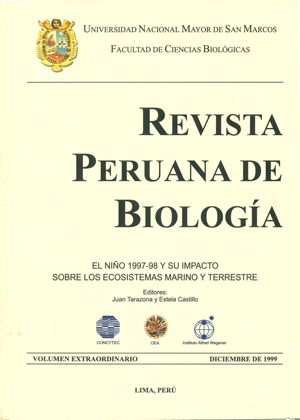Changes in prevalence of helminthic parasites of Emerita analoga by "El Niño 1997-98" effect
DOI:
https://doi.org/10.15381/rpb.v6i3.8432Keywords:
Helminthic parasites, Emerita analoga, prevalence, El Niño, LambayequeAbstract
Samplings of the Emerita analoga were taken biweekly with traps "cafan" on San Jose beach (Lambayeque-Peru) from March 1996 to November 1997. Cephalotoraxic length (mm) and total weight (0,001 g) was registered and the alimentary canal, gonads, and muscles were analyzed in order to look for parasites. The data were processed comparing statistically March 96 -March 97 (year 96) against those of the April -November 97 (El Niño 1997-98). The following parasites were present during 1996: Eutetrarhynchus (cestod), Polymorphus (acantocephala), Proleptus and Spiruroidea (nematode) and Marytrema (digeneo). During "El Niño 1997 -98" also appeared the cestod Nybelinia and another digeneo. The prevalence for Eutetrarhynchus and the nematodes, was major during "El Niño 1997-98" for both females and males: this same tendency was presented in the analysis 01 the number 01 the parasites/ ind., but diminished Pofymorphus and Marytrema. However, "El Niño 1997-98" events have no significant effect on the comparative allometric factor. The analysis of the evolution of the parasites throughout time evidenced that Eutetrarhynchus and the nematodes Proleptus and Spíruroídea, increased since February 1997 (before "El Niño 1997-98" beginning), which constitute a possibility to consider them as good biological indicators in early detection of "El Niño 1997-98" events.Downloads
Downloads
Published
Issue
Section
License
Copyright (c) 1999 Víctor Alvitres, Jorge Chanamé, Jorge Fupuy, Adela Chambergo, Miguel Cortez

This work is licensed under a Creative Commons Attribution-NonCommercial-ShareAlike 4.0 International License.
AUTHORS RETAIN THEIR RIGHTS:
a. Authors retain their trade mark rights and patent, and also on any process or procedure described in the article.
b. Authors retain their right to share, copy, distribute, perform and publicly communicate their article (eg, to place their article in an institutional repository or publish it in a book), with an acknowledgment of its initial publication in the Revista Peruana de Biologia.
c. Authors retain theirs right to make a subsequent publication of their work, to use the article or any part thereof (eg a compilation of his papers, lecture notes, thesis, or a book), always indicating its initial publication in the Revista Peruana de Biologia (the originator of the work, journal, volume, number and date).






